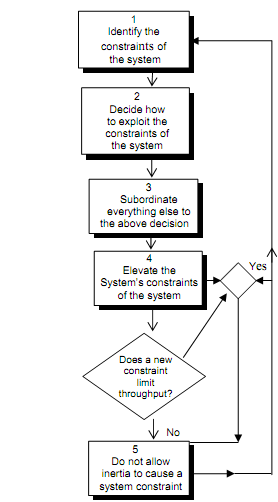Steps involved in TOC:
Constraint
Anything that limits a system from attaining highest performance verses its goal is the constraint.
Steps involved in TOC are shown in Figure
Step 1
Every system must have at least one constraint, limiting its output.
The more complicated the system, the less independent procedure paths exist, so the lower the number of constraints. In general, complex systems have only one constraint at a given time.
Recognize the system constraints. Constraints of weakest link are a critical link. Unless weakest link is strengthened by eliminating the constraints, no development is possible.
Step 2
Exploit the system constraints. A system of optimum procedure cannot 'be an optimum system.
Step 3
Subordinate everything else to that decision by aligning every other part of the system to support the constraints. This can sometimes eliminates the efficiency of non-constraint resources.
Step 4
Elevate the system constraints. For insufficient output, acquire more resources so that it is not a constraint now.
Step 5
Ignore inertia to become the system constraint. If the constraint has already been determined, go to Step 1. For continuous development, recognize constraints, break them, and repeat the procedure again and again.
An optimum system runs the constraint (or bottleneck) at optimum capacity (focused on the goal of the system), and all of other process steps must have excess capacity.

Figure: Focusing Steps in TOC